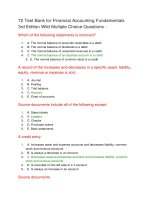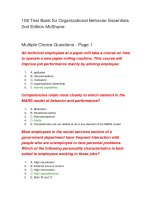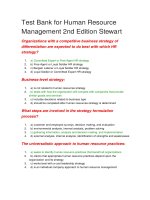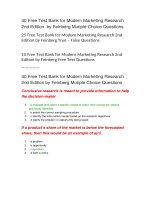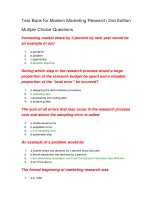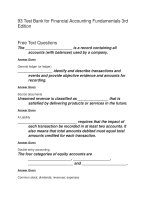test bank for financial accounting canadian 2nd edition by waybright kemp elbarrad
Bạn đang xem bản rút gọn của tài liệu. Xem và tải ngay bản đầy đủ của tài liệu tại đây (568.7 KB, 65 trang )
Financial Accounting, 2nd Cdn. Ed. (Waybright)
Chapter 2 Analyzing and Recording Business Transactions
2.1 Define accounts and understand how they are used in accounting
1) A listing of all accounts in numerical order is called a chart of accounts.
Answer: TRUE
Diff: 1
LO: 2-1 Define accounts and understand how they are used in accounting
Skill: Recall
Blooms: Knowledge
2) Account titles such as marketing expense and depreciation expense would be numbered starting with a
3.
Answer: FALSE
Diff: 1
LO: 2-1 Define accounts and understand how they are used in accounting
Skill: Recall
Blooms: Knowledge
3) An account numbered 321 would be considered a shareholders' equity account as it begins with a 3.
Answer: TRUE
Diff: 1
LO: 2-1 Define accounts and understand how they are used in accounting
Skill: Recall
Blooms: Knowledge
4) Items of value that a company owns are called shareholders' equity.
Answer: FALSE
Diff: 1
LO: 2-1 Define accounts and understand how they are used in accounting
Skill: Recall
Blooms: Knowledge
5) The shareholders' equity section would include the accounts such as retained earnings and revenues.
Answer: TRUE
Diff: 1
LO: 2-1 Define accounts and understand how they are used in accounting
Skill: Recall
Blooms: Knowledge
1
© 2016 Pearson Canada Inc.
6) Which is part of shareholders' equity?
A) Cash
B) Notes payable
C) Dividends
D) Assets
E) Liabilities
Answer: C
Diff: 1
LO: 2-1 Define accounts and understand how they are used in accounting
Skill: Recall
Blooms: Knowledge
7) Dividends are paid with cash to shareholders. Dividends are in what category of the chart of accounts?
A) Revenue
B) Assets
C) Shareholders' equity
D) Liabilities
E) Revenue
Answer: C
Diff: 2
LO: 2-1 Define accounts and understand how they are used in accounting
Skill: Recall
Blooms: Knowledge
8) Dividends, revenues, and expenses all:
A) start with the same chart of accounts number.
B) start with different chart of accounts numbers.
C) appear in the chart of accounts under assets.
D) appear in the chart of accounts under liabilities.
E) do not appear in the chart of accounts.
Answer: B
Diff: 1
LO: 2-1 Define accounts and understand how they are used in accounting
Skill: Recall
Blooms: Knowledge
9) Which of the following would start with a 1 in the chart of accounts?
A) Land and buildings
B) Depreciation expense and marketing expense
C) Merchandise sales and rent revenue
D) Common shares and cash
E) Accounts payable and notes payable
Answer: A
Diff: 1
LO: 2-1 Define accounts and understand how they are used in accounting
Skill: Recall
Blooms: Knowledge
2
© 2016 Pearson Canada Inc.
10) Which of the following would start with a 2 in the chart of accounts?
A) Income taxes to be paid and wages to be paid
B) Common shares and preferred shares
C) Cash and accounts receivable
D) Sales and fees revenue
E) Marketing expense and rent expense
Answer: A
Diff: 1
LO: 2-1 Define accounts and understand how they are used in accounting
Skill: Recall
Blooms: Knowledge
11) A chart of accounts includes:
A) balances of accounts.
B) names of customers
C) assets and liabilities.
D) accounts with unusual balances.
E) account activity.
F) vendor account balances.
Answer: C
Diff: 1
LO: 2-1 Define accounts and understand how they are used in accounting
Skill: Recall
Blooms: Knowledge
12) Which of the following is an expense account?
A) Prepaid insurance
B) Advertising
C) Accounts payable
D) Cash
E) Notes payable
Answer: B
Diff: 1
LO: 2-1 Define accounts and understand how they are used in accounting
Skill: Recall
Blooms: Knowledge
13) Which of the following is a revenue account?
A) Professional fees
B) Accounts payable
C) Accounts receivable
D) Wages
E) Cash
Answer: A
Diff: 1
LO: 2-1 Define accounts and understand how they are used in accounting
Skill: Recall
Blooms: Knowledge
3
© 2016 Pearson Canada Inc.
14) Marketing expenditures account 511 would belong to what category of accounts?
Answer: Expenses
Diff: 1
LO: 2-1 Define accounts and understand how they are used in accounting
Skill: Recall
Blooms: Knowledge
15) Monies owed to a company on a written promise to pay a fixed amount of money by a certain date
would be called a ________.
Answer: note payable
Diff: 2
LO: 2-1 Define accounts and understand how they are used in accounting
Skill: Recall
Blooms: Knowledge
16) Accounts starting with the number 4 would typically represent ________.
Answer: revenues
Diff: 1
LO: 2-1 Define accounts and understand how they are used in accounting
Skill: Recall
Blooms: Knowledge
17) An account starting with a number 1 would indicate ________.
Answer: an asset
Diff: 1
LO: 2-1 Define accounts and understand how they are used in accounting
Skill: Recall
Blooms: Knowledge
18) Accounts that start with the numbers 6-9 would probably be ________.
Answer: other revenues and expenses
Diff: 1
LO: 2-1 Define accounts and understand how they are used in accounting
Skill: Recall
Blooms: Knowledge
19) The order in which accounts appear in the chart of accounts is: ________.
Answer: assets, liabilities, shareholders' equity, revenues, expenses
Diff: 1
LO: 2-1 Define accounts and understand how they are used in accounting
Skill: Recall
Blooms: Knowledge
4
© 2016 Pearson Canada Inc.
20) Items such as wages and interest that have been incurred, but not yet paid, are called ________.
Answer: accrued liabilities
Diff: 1
LO: 2-1 Define accounts and understand how they are used in accounting
Skill: Recall
Blooms: Knowledge
21) Obligations that are owed to others due to past transactions are categorized as ________.
Answer: liabilities
Diff: 1
LO: 2-1 Define accounts and understand how they are used in accounting
Skill: Recall
Blooms: Knowledge
22) All payables are listed as ________.
Answer: liabilities
Diff: 1
LO: 2-1 Define accounts and understand how they are used in accounting
Skill: Recall
Blooms: Knowledge
23) A type of company asset in which a customer owes the company money would be a ________.
Answer: receivable
Diff: 1
LO: 2-1 Define accounts and understand how they are used in accounting
Skill: Recall
Blooms: Knowledge
24) Land, cash, office equipment, and accounts receivable belong to what category of accounts?
Answer: Assets
Diff: 1
LO: 2-1 Define accounts and understand how they are used in accounting
Skill: Recall
Blooms: Knowledge
25) A promissory note owed to another company would most likely appear in which categories?
Answer: Notes payable
Diff: 1
LO: 2-1 Define accounts and understand how they are used in accounting
Skill: Recall
Blooms: Knowledge
5
© 2016 Pearson Canada Inc.
26) List the order in which each of the following accounts would appear in a chart of accounts.
Utilities expenses, Tax return revenue, Accounts receivable, Income taxes payable
Answer: Accounts receivable, Income tax payable, Tax return revenue, Utilities expenses
Diff: 2
LO: 2-1 Define accounts and understand how they are used in accounting
Skill: Application
Blooms: Application
27) Expenses paid in advance such as rent and insurance are classified as prepaid expenses. Into what
category are they placed?
Answer: Assets
Diff: 2
LO: 2-1 Define accounts and understand how they are used in accounting
Skill: Application
Blooms: Application
28) Payment of a telephone bill in the same month that it is received is a(n) ________.
Answer: expense
Diff: 2
LO: 2-1 Define accounts and understand how they are used in accounting
Skill: Application
Blooms: Application
29) Obligations owed by a company to banks, for instance, are called ________.
Answer: notes payable
Diff: 2
LO: 2-1 Define accounts and understand how they are used in accounting
Skill: Application
Blooms: Application
30) Net income and dividends are part of ________.
Answer: shareholders' equity
Diff: 1
LO: 2-1 Define accounts and understand how they are used in accounting
Skill: Recall
Blooms: Knowledge
6
© 2016 Pearson Canada Inc.
31) Review the transactions below and determine whether you would use a debit or a credit to record the
following changes. Indicate your decision by entering "Debit" or "Credit" in the right-hand column.
1. An increase in Wage Expense
2. A decrease in Notes Payable
3. An increase in Prepaid Insurance
4. An increase in Common Shares
5. A decrease in Office Supplies
6. An increase in Dividends
7. An increase in Revenue
8. A decrease in Notes Receivable
9. An increase in Advertising Expense
10. A decrease in Cash
Answer:
1. An increase in Wage Expense
2. A decrease in Notes Payable
3. An increase in Prepaid Insurance
4. An increase in Common Shares
5. A decrease in Office Supplies
6. An increase in Dividends
7. An increase in Revenue
8. A decrease in Notes Receivable
9. An increase in Advertising Expense
10. A decrease in Cash
Debit
Debit
Debit
Credit
Credit
Debit
Credit
Credit
Debit
Credit
Diff: 3
LO: 2-2 Explain debits, credits and the double entry system of accounting
Skill: Critical Thinking
Blooms: Analysis
7
© 2016 Pearson Canada Inc.
32) For the following general ledger accounts, identify the normal balance of the account.
Example:
Accounts Payable
Credit
Accounts Receivable
Building
Cash
Common Shares
Dividends
Equipment
Inventory
Land
Notes Payable
Office Equipment
Office Supplies
Rental Expense
Service Revenue
Travel Expense
Utilities Expense
Wages Expense
Answer:
Accounts Payable
Accounts Receivable
Building
Cash
Common Shares
Dividends
Equipment
Inventory
Land
Notes Payable
Office Equipment
Office Supplies
Rental Expense
Service Revenue
Travel Expense
Utilities Expense
Wages Expense
Credit
Debit
Debit
Debit
Credit
Debit
Debit
Debit
Debit
Credit
Debit
Debit
Debit
Credit
Debit
Debit
Debit
Diff: 2
LO: 2-1 Define accounts and understand how they are used in accounting
Skill: Concept
Blooms: Comprehension
8
© 2016 Pearson Canada Inc.
33) For the accounts listed below, identify the type of account. Is it an (A) Asset, (L) Liability, (S)
Shareholders equity, (R) Revenue, or (E) Expense.
Accounts Payable
Accounts Receivable
Building
Cash
Common Shares
Dividends
Equipment
Inventory
Land
Notes Payable
Office Equipment
Office Supplies
Rental Expense
Service Revenue
Travel Expense
Utilities Expense
Wages Expense
Answer:
Accounts Payable
L
Accounts Receivable
A
Building
A
Cash
A
Common Shares
S
Dividends
S
Equipment
A
Inventory
A
Land
A
Notes Payable
L
Office Equipment
A
Office Supplies
A
Rental Expense
E
Service Revenue
R
Travel Expense
E
Utilities Expense
E
Wages Expense
E
Diff: 2
LO: 2-1 Define accounts and understand how they are used in accounting
Skill: Concept
Blooms: Comprehension
9
© 2016 Pearson Canada Inc.
34) For the accounts listed below, determine the normal balance of the account is it a debit or credit.
Accounts
1. Revenue
2. Cash
3. Accounts Receivable
4. Accounts Payable
5. Retained Earnings
6. Prepaid Insurance
7. Insurance Expense
8. Wages Expense
9. Office Building
10. Notes Receivable
11. Sales
12. Common Shares
Normal Balance
Debit or Credit
Answer:
Accounts
1. Revenue
2. Cash
3. Accounts Receivable
4. Accounts Payable
5. Retained Earnings
6. Prepaid Insurance
7. Insurance Expense
8. Wages Expense
9. Office Building
10. Notes Receivable
11. Sales
12. Common Shares
Normal Balance
Debit or Credit
Credit
Debit
Debit
Credit
Credit
Debit
Debit
Debit
Debit
Debit
Credit
Credit
Diff: 3
LO: 2-1 Define accounts and understand how they are used in accounting
Skill: Critical Thinking
Blooms: Analysis
10
© 2016 Pearson Canada Inc.
35) Hugh Munroe sells fine china in its antique store. A customer named Jacob Xie purchases a collectors'
plate from the store for $5,000 and agrees to pay this within 90 days of purchase. After 90 days passed
Xie was unable to pay for the collectors' plate. Munroe agreed to convert the receivable into an interest
bearing note with a term of one year and an interest rate of 10%. Does the note meet the definition of an
asset? Explain in detail why that is the case or not the case.
Answer: Yes, the note in this case does meet the definition of an asset because it arose out of a transaction
with a customer and it is expected to generate economic benefits in the future. It is a current asset because
it is expected to be collected within a year.
Diff: 3
LO: 2-1 Define accounts and understand how they are used in accounting
Skill: Concept
Blooms: Comprehension
36) A customer purchases a tuxedo from a company called Tuxedo Deluxe. The tuxedo was purchased
for $1,000. The tuxedo had to be tailor fit to the customer's specifications, so as per company policy a 10%
deposit was required from the customer. The customer paid the $100 deposit. Does this deposit meet the
definition of a liability? Explain in detail why that is the case or not the case.
Answer: The deposit does meet the definition of a liability because there is a present obligation for
Tuxedo Deluxe to deliver a suit that fits the specifications of the customer. The deposit is an unearned
revenue because the transaction will only be complete when Tuxedo Deluxe delivers the suit to the
customer.
Diff: 3
LO: 2-1 Define accounts and understand how they are used in accounting
Skill: Concept
Blooms: Comprehension
37) Game Genie paid out 10% of its earnings to its shareholders. Does this meet the definition of equity?
Explain in detail why that is the case or not the case.
Answer: These are dividends. This meets the definition of equity because it is considered a distribution
to the owners. It represents a reduction in retained earnings and shareholder's equity.
Diff: 3
LO: 2-1 Define accounts and understand how they are used in accounting
Skill: Concept
Blooms: Comprehension
11
© 2016 Pearson Canada Inc.
2.2 Explain debits, credits, and the double entry system of accounting
1) Double-entry accounting requires that every business transaction impacts at least two different
accounts.
Answer: TRUE
Diff: 1
LO: 2-2 Explain debits, credits and the double entry system of accounting
Skill: Recall
Blooms: Knowledge
2) The debit (left) side of an account always indicates an increase in the value of the account.
Answer: FALSE
Diff: 1
LO: 2-2 Explain debits, credits and the double entry system of accounting
Skill: Recall
Blooms: Knowledge
3) A T-account is a way to visualize the increases and decreases to the value of an account.
Answer: TRUE
Diff: 1
LO: 2-2 Explain debits, credits and the double entry system of accounting
Skill: Recall
Blooms: Knowledge
4) Accounts that decrease on the credit side are liabilities, common shares, revenues, and retained
earnings.
Answer: FALSE
Diff: 1
LO: 2-2 Explain debits, credits and the double entry system of accounting
Skill: Recall
Blooms: Knowledge
5) The credit (right) side of an account shows an increase or decrease depending upon the type of
account.
Answer: TRUE
Diff: 1
LO: 2-2 Explain debits, credits and the double entry system of accounting
Skill: Recall
Blooms: Knowledge
6) Accounts that increase on the credit side are assets, dividends, and expenses.
Answer: FALSE
Diff: 1
LO: 2-2 Explain debits, credits and the double entry system of accounting
Skill: Recall
Blooms: Knowledge
12
© 2016 Pearson Canada Inc.
7) Normal balance refers to the positive increase of an account and identifies the side of the account
(Debit or Credit) to which this positive balance is recorded.
Answer: TRUE
Diff: 1
LO: 2-2 Explain debits, credits and the double entry system of accounting
Skill: Recall
Blooms: Knowledge
8) Dividends paid out to shareholders are a liability.
Answer: FALSE
Diff: 1
LO: 2-2 Explain debits, credits and the double entry system of accounting
Skill: Recall
Blooms: Knowledge
9) A promissory note with a term of 10% and a term of one year is an asset.
Answer: TRUE
Diff: 1
LO: 2-2 Explain debits, credits and the double entry system of accounting
Skill: Recall
Blooms: Knowledge
10) Which of the following is an unofficial tool of accounting?
A) Account
B) T-account
C) Debit
D) Credit
E) Accountant
Answer: B
Diff: 1
LO: 2-2 Explain debits, credits and the double entry system of accounting
Skill: Recall
Blooms: Knowledge
11) Accounts payable, taxes payable, and notes payable increase on the debit side and decrease on the
credit side.
Answer: FALSE
Diff: 2
LO: 2-2 Explain debits, credits and the double entry system of accounting
Skill: Recall
Blooms: Knowledge
13
© 2016 Pearson Canada Inc.
12) The T-account aids in separating:
A) increases and decreases in an account.
B) the equality of the credits.
C) the equality of debits and credits in the accounting equation.
D) the balances of all of the accounts.
E) errors and omissions.
Answer: A
Diff: 1
LO: 2-2 Explain debits, credits and the double entry system of accounting
Skill: Recall
Blooms: Knowledge
13) Credit means:
A) decrease.
B) increase.
C) the right side of an account.
D) the left side of an account.
E) the total of the T-account.
Answer: C
Diff: 1
LO: 2-2 Explain debits, credits and the double entry system of accounting
Skill: Recall
Blooms: Knowledge
14) An example of accounts with normal debit balances would be:
A) liabilities.
B) expenses.
C) revenues.
D) shareholders' equity.
E) retained earnings
Answer: B
Diff: 1
LO: 2-2 Explain debits, credits and the double entry system of accounting
Skill: Recall
Blooms: Knowledge
15) An example of accounts with normal credit balances would be:
A) revenues.
B) assets.
C) expenses.
D) dividends.
E) accounts receivable.
Answer: A
Diff: 1
LO: 2-2 Explain debits, credits and the double entry system of accounting
Skill: Recall
Blooms: Knowledge
14
© 2016 Pearson Canada Inc.
16) The difference between the total debits and total credits of an account is called a:
A) trial balance.
B) sub-total.
C) ruling.
D) balance.
E) normal balance.
Answer: D
Diff: 1
LO: 2-2 Explain debits, credits and the double entry system of accounting
Skill: Recall
Blooms: Knowledge
17) The fact that each transaction has a dual effect on the accounting equation provides the basis for what
is called:
A) single-entry accounting.
B) double-entry accounting.
C) compound-entry accounting.
D) multiple-entry accounting.
E) re-allocation of accounting.
Answer: B
Diff: 1
LO: 2-2 Explain debits, credits and the double entry system of accounting
Skill: Recall
Blooms: Knowledge
18) Debit means:
A) decrease.
B) increase.
C) the right side of an account.
D) the left side of an account.
E) the total of the T-account.
Answer: D
Diff: 1
LO: 2-2 Explain debits, credits and the double entry system of accounting
Skill: Recall
Blooms: Knowledge
19) A T-account has a $759 debit balance. This account is most likely:
A) accounts payable.
B) sales revenue.
C) accounts receivable.
D) common share.
E) notes payable.
Answer: C
Diff: 2
LO: 2-2 Explain debits, credits and the double entry system of accounting
Skill: Application
Blooms: Application
15
© 2016 Pearson Canada Inc.
20) A T-account has a $509 credit balance. This account is most likely:
A) common shares.
B) land.
C) advertising expense.
D) dividends.
E) cash.
Answer: A
Diff: 2
LO: 2-2 Explain debits, credits and the double entry system of accounting
Skill: Application
Blooms: Application
21) A T-account has a $382 debit balance. This account is most likely:
A) income taxes payable.
B) common shares.
C) cash.
D) magazine sales.
E) sales revenue.
Answer: C
Diff: 2
LO: 2-2 Explain debits, credits and the double entry system of accounting
Skill: Application
Blooms: Application
22) A T-account has a $299 debit balance. This account is most likely:
A) accounts receivable.
B) bicycle repairs revenue.
C) wages payable.
D) common shares.
E) service fees.
Answer: A
Diff: 2
LO: 2-2 Explain debits, credits and the double entry system of accounting
Skill: Application
Blooms: Application
23) A T-account has a $922 credit balance. This account is most likely:
A) office equipment.
B) rent expense.
C) dividends.
D) sales revenue.
E) cash.
Answer: D
Diff: 2
LO: 2-2 Explain debits, credits and the double entry system of accounting
Skill: Application
Blooms: Application
16
© 2016 Pearson Canada Inc.
24) A promissory note with a term of one year and a rate of 5% is considered a(n):
A) Notes Receivable
B) Accounts Receivable
C) Dividends
D) Prepaid Expenses
E) Revenue
Answer: A
Diff: 2
LO: 2-2 Explain debits, credits and the double entry system of accounting
Skill: Application
Blooms: Application
25) A deposit received for custom-made furniture is considered a(n):
A) Accounts Receivable
B) Notes Receivable
C) Unearned Revenue
D) Accounts Payable
E) Revenue
Answer: C
Diff: 2
LO: 2-1 Define accounts and understand how they are used in accounting
Skill: Application
Blooms: Application
26) XYZ reported the following results for fiscal year 20X4:
Assets
$ 50,000
Liabilities
$ 10,000
Common Shares
$ 10,000
Revenue
$ 40,000
Expenses
?
Dividends
$ 5,000
What were the expenses reported by XYZ in 20X4?
A) $10,000
B) $5,000
C) $20,000
D) $30,000
E) $40,000
Answer: B
Diff: 2
LO: 2-2 Explain debits, credits and the double entry system of accounting
Skill: Application
Blooms: Application
17
© 2016 Pearson Canada Inc.
27) An investment of cash in a business increases which account?
Answer: Cash
Diff: 2
LO: 2-2 Explain debits, credits and the double entry system of accounting
Skill: Application
Blooms: Application
28) Name the three major parts of a T-account.
Answer: 1. A title
2. A debit side
3. A credit side
Account Title ( Name)
|
Debit
|
Credit
|
Diff: 2
LO: 2-2 Explain debits, credits and the double entry system of accounting
Skill: Concept
Blooms: Comprehension
29) What is the normal account balance for revenue, accounts receivable, and common shares?
Answer: credit, debit, and credit, respectively
Diff: 1
LO: 2-2 Explain debits, credits and the double entry system of accounting
Skill: Recall
Blooms: Knowledge
30) Office furniture, wages payable, and dividends have normal balances of ________, ________, and
________, respectively.
Answer: debit, credit, and debit
Diff: 1
LO: 2-2 Explain debits, credits and the double entry system of accounting
Skill: Recall
Blooms: Knowledge
31) The retained earnings accounts of dividends, revenues, and expenses have normal balances of
________, ________, and ________, respectively.
Answer: debit, credit, and debit
Diff: 1
LO: 2-2 Explain debits, credits and the double entry system of accounting
Skill: Recall
Blooms: Knowledge
18
© 2016 Pearson Canada Inc.
32) The total amount of debits must equal the total amount of credits. This is a rule of ________.
Answer: double-entry accounting
Diff: 1
LO: 2-2 Explain debits, credits and the double entry system of accounting
Skill: Recall
Blooms: Knowledge
33) Cash, common shares, and advertising expense have normal balances of ________, ________, and
________, respectively.
Answer: debit, credit, and debit
Diff: 2
LO: 2-2 Explain debits, credits and the double entry system of accounting
Skill: Concept
Blooms: Comprehension
34) Dividends, accounts receivable, and buildings have normal balances of ________, ________, and
________, respectively.
Answer: debit, debit, and debit
Diff: 2
LO: 2-2 Explain debits, credits and the double entry system of accounting
Skill: Concept
Blooms: Comprehension
35) The Sunglasses Hut pays wages in the amount of $13,579. Provide the transaction details.
Answer: Debits Wages Expense 13,579
Credit Cash
$13,579
Diff: 2
LO: 2-2 Explain debits, credits and the double entry system of accounting
Skill: Concept
Blooms: Comprehension
19
© 2016 Pearson Canada Inc.
36) Freddy's Fir Tree Company is a new business. The following accounts are required in the general
ledger.
Accounts Payable
Cash
Equipment
Sales/Revenue
Insurance Expense
Retained Earnings
Prepaid Insurance
Accounts Receivable
Prepaid Rent
Rent Expense
Salary Expense
Salaries Payable
Supplies
Supplies Expense
Organize the accounts into the order in which they should appear in the general ledger of Freddy's Fir
Tree Company and assign account numbers.
Use the following system to assign account numbers.
1000–1999 Assets
2000–2999 Liabilities
3000–3999 Shareholder's equity account
4000–4999 Revenues
5000–5999 Expenses
Answer: There are several possible correct account numbers. The first digit needs to align with the
assigned account numbers. The order of the accounts is important.
100110121013101410151060-
Cash
Accounts Receivable
Supplies
Prepaid Insurance
Prepaid Rent
Equipment
2010- Accounts Payable
2020- Salaries Payable
3010- Retained Earnings
4010- Sales Revenue
5010502050305040-
Salary Expense
Supplies Expense
Rent Expense
Insurance Expense
Diff: 3
LO: 2-1 Define accounts and understand how they are used in accounting
Skill: Application
Blooms: Application
20
© 2016 Pearson Canada Inc.
37) Tito Corporation started business in 2015 and reported the following results:
Assets
$ 85,000
Liabilities
$ 25,000
Common Shares
$ 15,000
Revenue
$ 100,000
Expenses
$ 20,000
Dividends
?
Calculate the total dividends paid out.
Answer: Dividends = $35,000 ($25,000 + $15,000 + $100,000 - $85,000 - $20,000)
Diff: 3
LO: 2-2 Explain debits, credits and the double entry system of accounting
Skill: Application
Blooms: Application
2.3 Demonstrate the use of the general journal and the general ledger to record
business transactions
1) The general journal was developed to organize transactions by account.
Answer: FALSE
Diff: 1
LO: 2-3 Demonstrate the use of the general journal and the general ledger to record business transactions
Skill: Recall
Blooms: Knowledge
2) The posting reference column of the general ledger shows the sources of the transferred information.
Answer: TRUE
Diff: 1
LO: 2-3 Demonstrate the use of the general journal and the general ledger to record business transactions
Skill: Recall
Blooms: Knowledge
3) The general journal is used to record only the revenue transactions of a business.
Answer: FALSE
Diff: 1
LO: 2-3 Demonstrate the use of the general journal and the general ledger to record business transactions
Skill: Recall
Blooms: Knowledge
4) Recording a transaction in the general journal is called "journalizing" the transaction.
Answer: TRUE
Diff: 1
LO: 2-3 Demonstrate the use of the general journal and the general ledger to record business transactions
Skill: Recall
Blooms: Knowledge
21
© 2016 Pearson Canada Inc.
5) Journalizing is the transfer of information from the general journal to the general ledger.
Answer: FALSE
Diff: 1
LO: 2-3 Demonstrate the use of the general journal and the general ledger to record business transactions
Skill: Recall
Blooms: Knowledge
6) The posting reference column of the general journal will include the number of the account to which
the information is being posted.
Answer: TRUE
Diff: 1
LO: 2-3 Demonstrate the use of the general journal and the general ledger to record business transactions
Skill: Recall
Blooms: Knowledge
7) Transactions are recorded in order of the dollar amount of the transaction.
Answer: FALSE
Diff: 1
LO: 2-3 Demonstrate the use of the general journal and the general ledger to record business transactions
Skill: Recall
Blooms: Knowledge
8) Chronological order dictates the order in which transactions are journalized.
Answer: TRUE
Diff: 1
LO: 2-3 Demonstrate the use of the general journal and the general ledger to record business transactions
Skill: Recall
Blooms: Knowledge
9) Dividends are considered a contra-equity account.
Answer: TRUE
Diff: 1
LO: 2-3 Demonstrate the use of the general journal and the general ledger to record business transactions
Skill: Recall
Blooms: Knowledge
10) An owner that invests money into his/her business will increase its assets and decrease its equity.
Answer: FALSE
Diff: 1
LO: 2-3 Demonstrate the use of the general journal and the general ledger to record business transactions
Skill: Recall
Blooms: Knowledge
22
© 2016 Pearson Canada Inc.
11) A purchase of equipment on account will cause assets to increase and liabilities to increase.
Answer: TRUE
Diff: 1
LO: 2-3 Demonstrate the use of the general journal and the general ledger to record business transactions
Skill: Recall
Blooms: Knowledge
12) A payment of a dividend will decrease assets and decrease equity.
Answer: TRUE
Diff: 1
LO: 2-3 Demonstrate the use of the general journal and the general ledger to record business transactions
Skill: Recall
Blooms: Knowledge
13) A company that orders parts for its manufacturing process will need to journalize this transaction.
Answer: FALSE
Diff: 1
LO: 2-3 Demonstrate the use of the general journal and the general ledger to record business transactions
Skill: Recall
Blooms: Knowledge
14) Once you post the transaction to the general ledger, you must go back to the general journal and fill
in:
A) the date.
B) the amount debited or credited.
C) the posting reference column with the account number of the posting.
D) the account name that was involved in the transaction.
E) the dollar value.
Answer: C
Diff: 1
LO: 2-3 Demonstrate the use of the general journal and the general ledger to record business transactions
Skill: Concept
Blooms: Comprehension
15) Instead of T-accounts, businesses more than likely use a:
A) chart of accounts.
B) balance sheet.
C) general ledger.
D) general journal.
E) income statement.
Answer: C
Diff: 1
LO: 2-3 Demonstrate the use of the general journal and the general ledger to record business transactions
Skill: Concept
Blooms: Comprehension
23
© 2016 Pearson Canada Inc.
16) The posting reference column of the general journal provides a cross-reference between the:
A) ledger and accounts.
B) journal and ledger.
C) ledger and financial statements.
D) journal and financial statements.
E) ledger and customers.
Answer: B
Diff: 2
LO: 2-3 Demonstrate the use of the general journal and the general ledger to record business transactions
Skill: Concept
Blooms: Comprehension
17) A deposit received from a customer for a purchase will cause:
A) assets to increase and liabilities to decrease.
B) assets to increase and liabilities to increase.
C) liabilites to increase and equity to increase.
D) liabilites to decrease and equity to decrease.
E) assets to increase and equity to increase.
Answer: B
Diff: 2
LO: 2-3 Demonstrate the use of the general journal and the general ledger to record business transactions
Skill: Recall
Blooms: Knowledge
18) A collection of an outstanding accounts receivable will cause:
A) assets to increase and equity to decrease.
B) assets to increase and equity to increase.
C) no change in assets.
D) assets to decrease and equity to decrease.
E) assets to decrease and equity to increase.
Answer: C
Diff: 2
LO: 2-3 Demonstrate the use of the general journal and the general ledger to record business transactions
Skill: Recall
Blooms: Knowledge
19) Every entry in the general journal should include all of the following EXCEPT:
A) the title of each account affected.
B) the amounts of debits and credits.
C) a brief description of the transaction.
D) the balance of the accounts affected.
E) debits and credits.
Answer: D
Diff: 2
LO: 2-3 Demonstrate the use of the general journal and the general ledger to record business transactions
Skill: Concept
Blooms: Comprehension
24
© 2016 Pearson Canada Inc.
20) The general ledger is arranged in the __________order of the chart of accounts.
Answer: numerical
Diff: 1
LO: 2-3 Demonstrate the use of the general journal and the general ledger to record business transactions
Skill: Recall
Blooms: Knowledge
21) The ________ indicates where the information originated and to where the information was
transferred.
Answer: posting reference
Diff: 1
LO: 2-3 Demonstrate the use of the general journal and the general ledger to record business transactions
Skill: Recall
Blooms: Knowledge
22) The ________ keeps a running balance of an individual account.
Answer: general ledger
Diff: 1
LO: 2-3 Demonstrate the use of the general journal and the general ledger to record business transactions
Skill: Recall
Blooms: Knowledge
23) Jill invested $25,000 in her business, Fashion Unlimited. The journal entry would include a ________.
Answer: debit to cash for $25,000 and a credit to common shares for $25,000
Diff: 2
LO: 2-3 Demonstrate the use of the general journal and the general ledger to record business transactions
Skill: Application
Blooms: Application
24) Office equipment was purchased for $2,400 on account to Business Furniture Company. The journal
entry would include a ________.
Answer: debit to office equipment $2,400 and a credit to accounts payable $2,400
Diff: 2
LO: 2-3 Demonstrate the use of the general journal and the general ledger to record business transactions
Skill: Application
Blooms: Application
25) Salary expenses of $675 were paid in cash. The journal entry would include a ________.
Answer: debit to salary expense $675 and a credit to cash $675
Diff: 2
LO: 2-3 Demonstrate the use of the general journal and the general ledger to record business transactions
Skill: Application
Blooms: Application
25
© 2016 Pearson Canada Inc.
